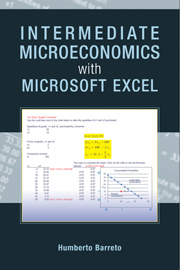Book contents
- Frontmatter
- Contents
- Preface
- User Guide
- Introduction
- PART I THE THEORY OF CONSUMER BEHAVIOR
- PART II THE THEORY OF THE FIRM
- 2.1 Production Function
- 2.2 Input Cost Minimization
- 2.3 Output Profit Maximization
- 2.4 Input Profit Maximization
- 2.5 Consistency in the Theory of the Firm
- 2.6 Monopoly
- 2.7 Game Theory
- PART III THE MARKET SYSTEM
- Conclusion
- Index
2.1 - Production Function
from PART II - THE THEORY OF THE FIRM
Published online by Cambridge University Press: 05 June 2012
- Frontmatter
- Contents
- Preface
- User Guide
- Introduction
- PART I THE THEORY OF CONSUMER BEHAVIOR
- PART II THE THEORY OF THE FIRM
- 2.1 Production Function
- 2.2 Input Cost Minimization
- 2.3 Output Profit Maximization
- 2.4 Input Profit Maximization
- 2.5 Consistency in the Theory of the Firm
- 2.6 Monopoly
- 2.7 Game Theory
- PART III THE MARKET SYSTEM
- Conclusion
- Index
Summary
Let us choose that function P′ = bLk Ck−1 and find such numerical values of b and k that P′ will “best” approximate P [product or output] in the sense of the Theory of Least Squares.
Then relative to the indices and the period we have the norm P′ = 1.01L3/4C1/4.
Charles W. Cobb and Paul H. DouglasThe production function is the backbone of the Theory of the Firm. It describes the current state of technology and how input can be transformed into output.
The production function can be displayed in a variety of ways, including product curves and isoquants. In every optimization problem faced by the firm, the production function is included.
Key Definitions and Assumptions
Inputs, or factors of production, are used to make output, or product. As shown in Figure 2.1.1.1, the firm is a highly abstract entity – a black box – that simply transforms inputs into output.
Inputs are often broken down into large categories: land, labor, raw materials, and capital. Capital can be confusing. Capital, K, as a factor of production means physical capital goods such as machinery, tools, or equipment. That is different from financial or venture capital that is a fund of money.
Like labor, capital is rented. The firm does not own any of its machines. This is extremely unrealistic but allows us to avoid complicated issues in- volving depreciation, financing of machinery purchases (debt versus equity, for example), and so on.
Information
- Type
- Chapter
- Information
- Intermediate Microeconomics with Microsoft Excel , pp. 265 - 278Publisher: Cambridge University PressPrint publication year: 2009
